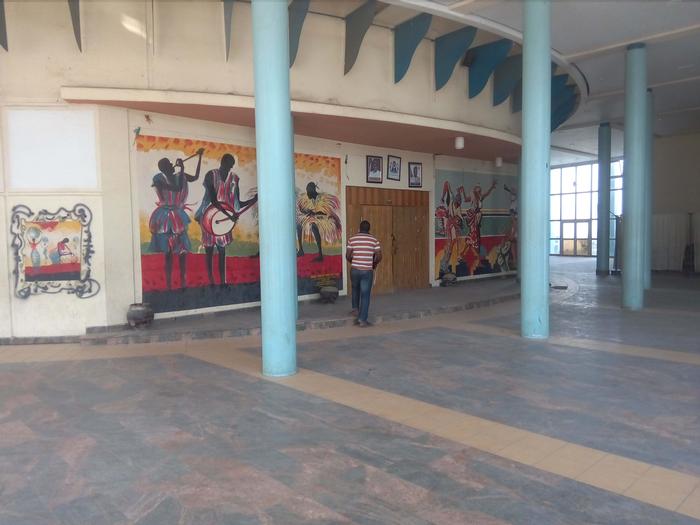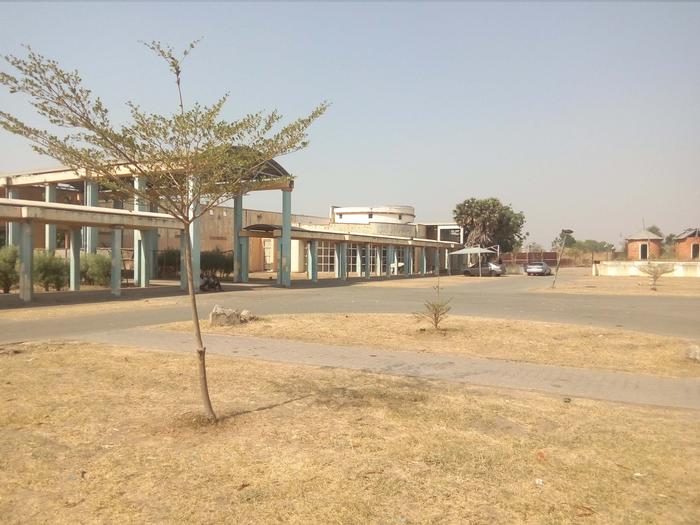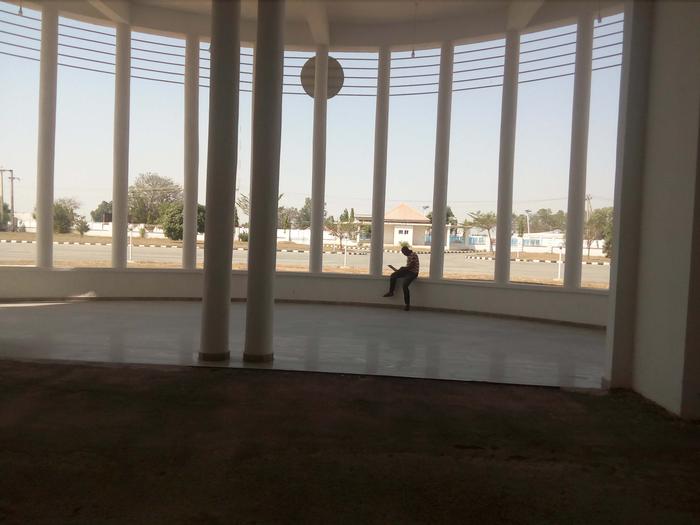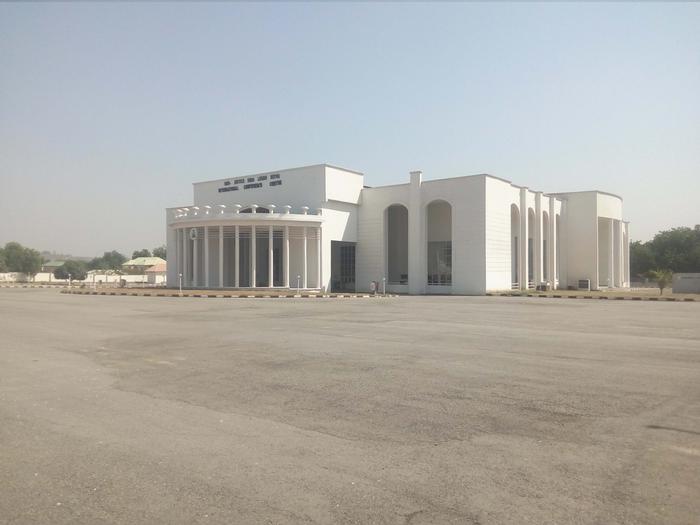[ID:3838] OF COMMUNITY AND WELL-BEING: AN ARCHITECTURE OF PEOPLENigeria The need for appropriate site selection for every civic building and the need to design the exterior and interior spaces to be user sensitive in creating meeting points that stimulates human interactions forms the basis of our interdisciplinary team-up and knowledge generation. Architecture and Urban planning students.
His name is Mohammed. It was right about dusk, the dry, cold harmattan wind from the Sahara blows across his face as he struggled to remove his clothes from the line to arrange them in a metal box. Tomorrow, he would be following the only bus leaving his Village, somewhere in the interior of Niger state, Nigeria to the state capital Minna, to live and learn a trade from his uncle. Up till now, Mohammed has lived his entire, short life in the Village. A life circled about communal living. There is the central village market, the local mill and of course, the “village square”; an open space and unofficial home for most social and civic functions. Ranging from the annual “Hawan doki”, the traditional horse riding during Sallah and coronation ceremonies, the weekly cultural displays every weekend, to numerous meetings by different groups of people living in small proximity on the part of the ruralities; the women, the youth and even the chieftains. The village square is the hub of all social activities. Will all these be over tomorrow? He thought intuitively as he bade farewell to the community that has served him so well and taught him true essence of harmonious living through communal living.
It was supposed to be a morning of light and stars as he stepped out of his compound that morning. However, it was cold and hazy. He would be leaving all his friends behind today. His lips kept smacking with cold in the gripping scene. He heard a flap of a dove’s wing then he turned a sharp stare at the fog behind the little red hut, there he saw the dove tweaking tauntingly at him. Almost instantly, she flew away, boarding love, light and so much peace. His eyes became dim as he helplessly watched her glide away into the void and so did his heart melt with it, leaving him in hollow and forlorn. He picked his metal box and headed for the bus stop.
That was a year ago. Mohammed, a young man from an interior rural community, having spent the last one year in the city, now craves for moments close to his root. A community within a larger community even within the city context. “You are homesick!” his uncle would say. To which Mohammed will reply, “No! I am not. The city life is sick!”
Life within the city is filled with “Every man with his own business”. A daily routine which has long neglected the togetherness and fellowship that formed the core of human interpersonal relationship with the environment and most importantly, its people.
In one of his numerous trips around the city carrying out his trade, on an extensively large billboard, he came across an advertisement of a cultural stage play at the UK Bello Art Theatre located in proximity to the popular indigenous market “Kasua n gwari”. He stared keenly at the billboard just like one would at an anticipated opportunity coupled with mixed feelings geared by uncertainty of what to expect. He however hoped this would be close to the weekly displays back at the village square.
Passing through “Kasua n gwari”, the large yet local indigenous market adjoining the Art theatre, Mohammed arrived at the entrance of the UK Bello Art Theatre. He alighted from the commercial tricycle as soon as it pulled up at the layby. With his striped shirt on a jogger boot, he bounced on the walkway in a youthful style. The site consists of a vast open space surrounded by dynamic buildings. To the left is a narrow pedestrian gate which opens into a wide, covered walkway which branches into the art theatre, a couple metres to the left upon entering.
The continuous, covered walkway when followed straight to the end without taking a turn, leads directly into the state museum. In a unique fashion, the Wide, covered walkway seamlessly connects the interior spaces of both the art theatre and the state museum to the exterior landscape. It also offers a space for meeting and connecting with people as one moves between the two buildings.
Tick-tuck the clock sounds. It was 3:30 pm. The stage play supposedly was to start later in the evening by 5:30 pm. Mohammed must have misread the time or probably, it was his anticipation that had brought him two hours earlier. He decided to utilize this time to explore the new and seemingly interesting environment. As he walked down the covered walkway towards the state museum, greeting almost everyone he met on his path, he expressed awe at the priceless view of the local, hut-styled gazebos on the horizon to his right; built to house smaller groups of people for meeting, connecting and relaxing.
The vast site houses alongside the theatre and the museum, the National Institute for Cultural Orientation (NICO), Niger state office. An institute saddled with the responsibility of harnessing culture for national development. The shape of the building plan is like a giant semi-circle, a horseshoe magnet concept that attracts visitors to its core. At the back of the building, the inward curve serves as a stage for an mini amphitheatre. With fixed concrete seats arranged in clusters on an elevated terrain surrounding the circular stage, it offers a clear view of the stage below. When no event is holding, the amphitheatre presents a spectacle of art as portrayed by artistic paintings on the curved wall at the back of the stage, attracting in people from the entrance towards the market extension. People who then form clusters on the seats provided. A focal point, an interface for meeting people seeking to relax their minds or think in a serene environment. The clusters of seats are shaded from solar radiation by giant trees with large canopies, giving a relaxing and inviting natural spot of a city park's equivalence.
The cloud goes eternal yellow-brown and the day became red cloudless, it was 5:15pm. The stage play will commence within the next quarter of the hour. Mohammed, having a feel of the moment walked leisurely across the open compound into the reception of the theatre hall; a wide circular corridor that buffers the theatre hall. The corridor is a circular space where traditional paintings, crafts, and artefacts are displayed on the walls and flower pots seating elegantly on the floor, creating a traditional scenery that connects every visitor to its view. As spectators including Mohammed arrive for the event, they are welcomed by the lavishly displayed artworks, flaunted radiantly at the entrance’s focus.
Mohammed met an elderly man in his northern regalia. He had come with his grandchildren to watch the stage play. He took him through the northern paintings and cultural drawings. Mohammed could not hold his joy as he soliloquizes “A day at the museum often translates to a day spent with loved ones as fathers and mothers transform into tour guides” this environment, indeed provides an opportunity for knowledge sharing and learning experiences.
Mohammed commented to a group of friends he had just met; two from the museum earlier and one from the amphitheatre “I have never felt so enthralled and full of energy since I left my village. The play is yet to commence yet I feel alive again as everything seems to work in a perfect harmony here. Adamu, the new friend from the amphitheatre merely nodded in approval with a big smile across his face as they walked gently to take their seats for the evening stage play.
Mohammed is a typical example of a traditional Hausa man from Northern Nigeria who places huge values on culture and finds solace in making new friends who shares similar value. When the environment looks “homely”; everything seems easier. Connecting with people inclusive.
Adamu, Mohammed’s newest friend has a similar background to his friend. Since moving to the city about the same time as Mohammed, he has continually decried the apparent neglect of his home community by the government. From the non-existent amenities in his village to the acclaimed power segregation. From his point of view, polarization effect of the state’s politics seemed overly evident in Adamu’s village and he had joined himself already to his village indigenous association represented within Minna city.
Experiencing moments bothering around his cultural stand and connecting with new people proofs refreshing. However, he believes there could be solid improvement in bringing the government closer to the locals as well as the locals closer to the government; bridging the gap between the affluent and the proles.
Stepping out of UK Bello Art theatre in the company of Mohammed and two others, after the stage play that evening, one of the two new friends invited the group for a town hall meeting holding in a fortnight. “The venue is Idris Legbo Kutigi International Conference Centre, located opposite the state government’s house” he said. Adamu’s eyes blinked rapidly at the mention of the venue, “State Government house?” he asked, rather rhetorically, trying to ensure his ears had not just deceived him. The new friend only nodded in approval, reached for his back pack and handed invitations to each member of the group “We will be there!” Adamu replied with a rather serious expression. As if speaking for the group.
Adamu alighted from his motorcycle and carefully wheeled it under the tree shading the Gatehouse of Idris Legbo kutigi International Conference Centre. He greeted the gate-man in the local Hausa dialect. Few people has arrived aside the organizers and the workers. He decided to take a walk round the site, absorbing in the calmness of the serene environment. To his right was a mini-hall with a swimming pool at its front and at the extreme end is a shade open on all sides and elevated about a metre from the natural ground level. A perfect spot for outdoor nexus with people who has come to take advantage of the natural air in the calm atmosphere.
To his left is the vast conference hall, so named to immortalize a former Nigerian Chief Justice of the Federation, Justice Idris Legbo Kutigi, in all its white majesty. Adamu moved closer to the building and took a spree walk around its end where the main entrance opens adjacently to the gate of the Niger State Government house currently undergoing modification and reconstruction. He gazed high into its top following with his eyes, the perfectly circular columns elegantly gracing the front porch and creating an ample space for meeting as people move to and from the conference hall. Conversing with a group of friends he just met at the circular entrance integrating the interior environment to the dynamically calm site, “I have never been so close to the seat of power” he said, not minding anyone’s reaction.
Just as he walked away from the entrance, he saw the governor’s convoy stopped over just at the front gate of the State house. In an unusual manner, the governor stepped out amidst security details and walked towards the gate, saying things Adamu’s ears could not pick a stone throw away. Up until now, Adamu has only seen the man behind the wheels of the state on colourful campaign banners on walls and streets of Minna city. Alas! Behold the man whose name is known to both great and small. He screamed “His excellency sir!” in a Hausa intonated voice as he waved vigorously at the governor. The governor in return waved back at him in a majestic manner similar to one of the numerous waves of hand in his political rallies. Later that evening, he would be addressing citizens who had gathered at the hall on some agenda towards moving the state forward. Present at the meeting include commissioners, advisers to the government, civil servants, as well as local traders such as Adamu and Mohammed. Seated in no hierarchical order.
People and places are inextricably linked. Our knowledge about life and how we move through and relate to the rest of the world is based on the environment where we were raised. A good example is what we found among the Hausas, where the local playground and landscape provides spaces to discuss and decide on social structure and processes.
The location of site and design of civic buildings can help to bring about frequent and meaningful connections between citizens of different classes, race, religion or background. The great an interface for healthy relations, the better chance we stand in bridging the gap created by political polarization in our communities as this creates a sense of being valued in every citizen, hence, creating a healthier well-being.
Architects therefore are to work closely with the Town Planners in selecting an appropriate site that is people oriented for locating civic buildings, as seen in the location of Legbo Kutigi hall, which is located in proximity to the seat of power and its psychological effects on users like Adamu. Also, UK Bello Art Theatre is located close to a large market within the city centre. A place well visible to many locals and one which connects them with their core values, in a cultural context, creating a space for solid human interactions. Architects are never to work alone. In designing civic buildings, sociologists also helps the architects in understanding the elements and rules of social interaction and hence, use this to design for the people; “creating architecture from people”. When all these are put to consideration, our civic buildings becomes a focal point, an interface where human relationship is encouraged. This goes a long away in positively affecting the well-being of the community. In conclusion, as displayed in Mohammed’s story, Design of communal spaces in civic buildings, must be one that portrays and upholds the values of the population it is to serve. Hence, as people are revealed by their values, we create an architecture of people.
References
Baldwin, C. (2014, February 24). A new approach: Social factors in urban development. Retrieved from The City Fix: https://thecityfix.com/blog/new-approach-social-factors-urban-development-cathy-baldwin/
Broadway Books. (2019). Select praise for Palaces for the People.
Dickinson, R. E. (2007). The Social Factor in City Planning. Journal of the American Institute of Planners, volume 12, page 5-10.
Glendinning A., Nuttal M., Hendy L., Kloep M., & Wood S. (2003). Rural Communities and Well-Being: A Good Place to Grow Up? Sage Jornals: The Sociological Review.
Klinenberg, E. (2018). Palaces For The People. New York: Crown Publishing Group, a division of Penguin Random House.
If you would like to contact this author, please send a request to info@berkeleyprize.org. |




